Some people reach for a jar of store-bought sauce when making pizza at home. But if you’ve ever felt disappointed by bland or sugary options, there’s an easy fix: pizza sauce from tomato paste. This method gives you full control over flavor and consistency without fuss. With just tomato paste, a few pantry staples, and about five minutes, you can blend a rich, tangy sauce that makes your pizza stand out. It’s also versatile—try it on pasta, breadsticks, or as a dipping sauce for appetizers.
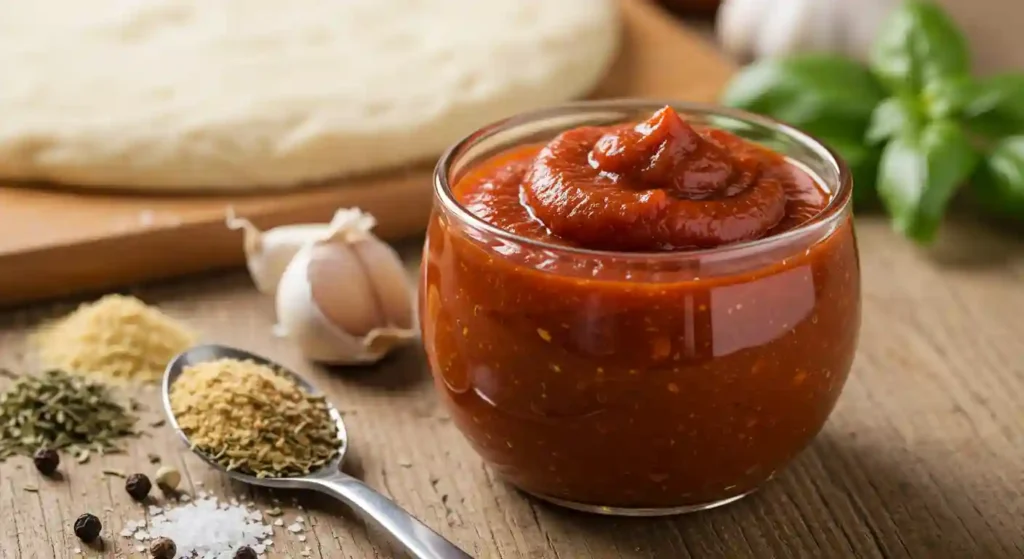
Whether you’re making a classic margherita, a fully loaded supreme, or a veggie-lovers’ pie, a quality sauce is essential. That’s why starting with tomato paste is so appealing—it’s cost-effective, shelf-stable, and easy to customize. Let’s explore why you’ll love this method and how to nail it each time.
Table of Contents
Why You’ll Love This Recipe
- Quick and Easy
No simmering for hours. Stir the ingredients together, and you’re ready to sauce your pizza dough. - Budget-Friendly
Tomato paste usually costs less than fancy jars of store-bought pizza sauce, giving you more control over taste and saving money. - Rich Flavor
Since tomato paste is concentrated, you only need a little to create a bold sauce that can outshine watery alternatives. - Customizable
Adjust sweetness, spice, or herbs. Some might add extra garlic or onion powder for a unique spin. - Versatile
Use it on breadsticks, as a dipping sauce, or in pasta. If you have leftover sauce, freeze it for later or store it in the fridge.
Ingredients
Most of these items might already be in your pantry:
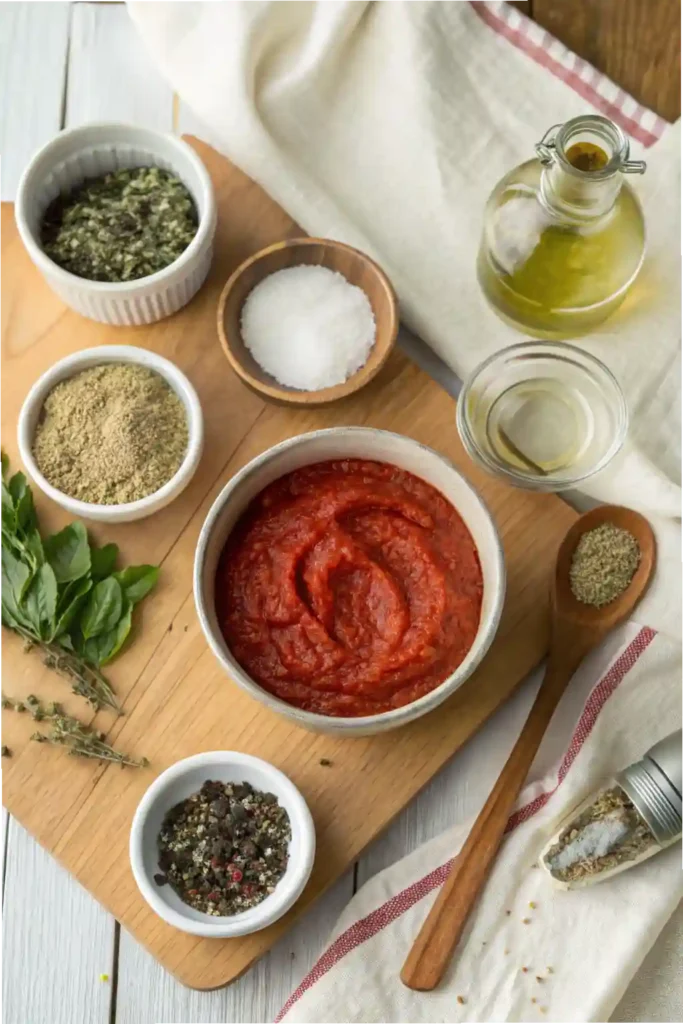
- Tomato Paste (6 oz can)
- Focus on plain tomato paste without added seasonings.
- Focus on plain tomato paste without added seasonings.
- Water (½ cup, or to desired consistency)
- Thins out the paste. Adjust as you prefer thicker or thinner sauce.
- Thins out the paste. Adjust as you prefer thicker or thinner sauce.
- Olive Oil (1 tablespoon)
- Brings smoothness and a bit of shine to the sauce.
- Brings smoothness and a bit of shine to the sauce.
- Italian Seasoning (1 teaspoon)
- A ready-made blend of dried basil, oregano, rosemary, and thyme. Or use your preferred combination.
- A ready-made blend of dried basil, oregano, rosemary, and thyme. Or use your preferred combination.
- Garlic Powder (½ teaspoon)
- Adds subtle garlic flavor without needing fresh garlic. Some prefer onion powder too.
- Adds subtle garlic flavor without needing fresh garlic. Some prefer onion powder too.
- Salt and Black Pepper (to taste)
- Fine-tune the base flavor. Start small, add more if needed.
- Fine-tune the base flavor. Start small, add more if needed.
- Sugar (1 teaspoon, optional)
- Balances the acidity of tomatoes. Skip if you prefer a tangy sauce.
- Balances the acidity of tomatoes. Skip if you prefer a tangy sauce.
- Crushed Red Pepper Flakes (optional, pinch)
- For those who like heat.
- For those who like heat.
(Optional extras: a dash of balsamic vinegar or a sprinkle of parmesan cheese can deepen flavor.)
Instructions
Follow these steps to make a simple, no-cook sauce:
- Gather Ingredients
- Open your 6 oz can of tomato paste. Measure out about ½ cup water. Grab your Italian seasoning, garlic powder, salt, pepper, and any optional extras you like.
- Open your 6 oz can of tomato paste. Measure out about ½ cup water. Grab your Italian seasoning, garlic powder, salt, pepper, and any optional extras you like.
- Mix Paste and Water
- In a small bowl, whisk tomato paste and ¼ cup water to start. Add more water gradually until the sauce reaches a spreadable consistency. Some people prefer thick sauce; others like it a bit thinner.

- Add Olive Oil and Seasonings
- Stir in 1 tablespoon olive oil. Then mix in 1 teaspoon Italian seasoning, ½ teaspoon garlic powder, plus salt and pepper to taste. If you want mild sweetness, include 1 teaspoon sugar. For heat, toss in a pinch of red pepper flakes.
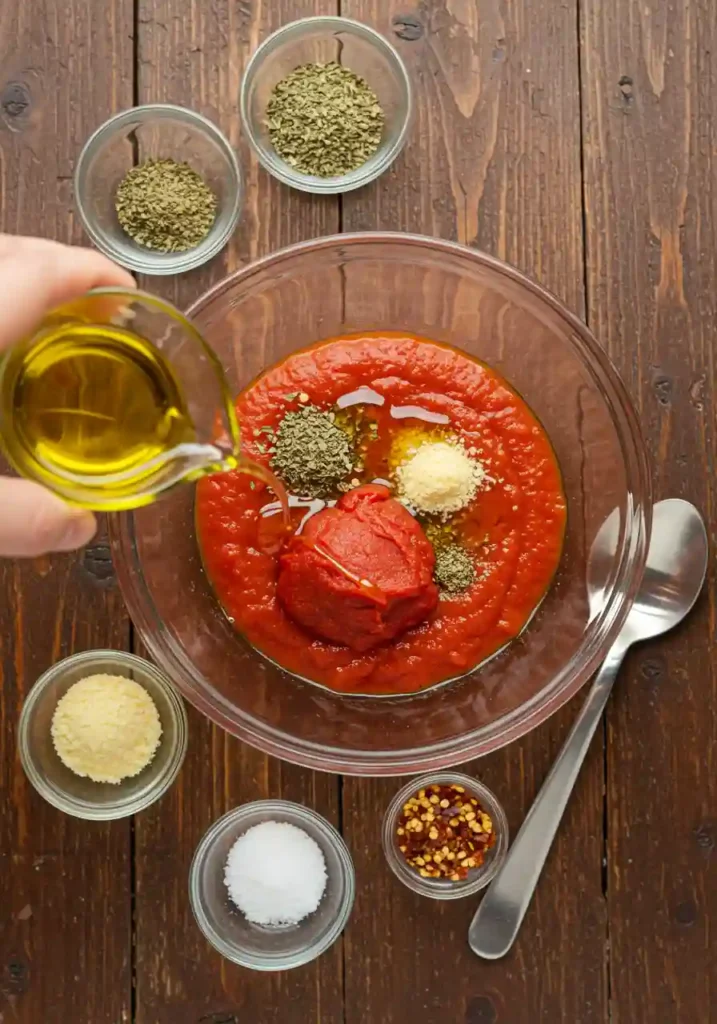
- Taste and Adjust
- Dip a spoon in and see if the sauce is too tangy, too thick, or lacking herbs. Add more sugar, water, or seasoning until it’s perfect for your taste buds.
- Dip a spoon in and see if the sauce is too tangy, too thick, or lacking herbs. Add more sugar, water, or seasoning until it’s perfect for your taste buds.
- Let It Sit (Optional)
- If you have 5–10 minutes, let the sauce rest so flavors meld. This step isn’t mandatory, but can slightly enhance taste.
- If you have 5–10 minutes, let the sauce rest so flavors meld. This step isn’t mandatory, but can slightly enhance taste.
- Use Immediately or Store
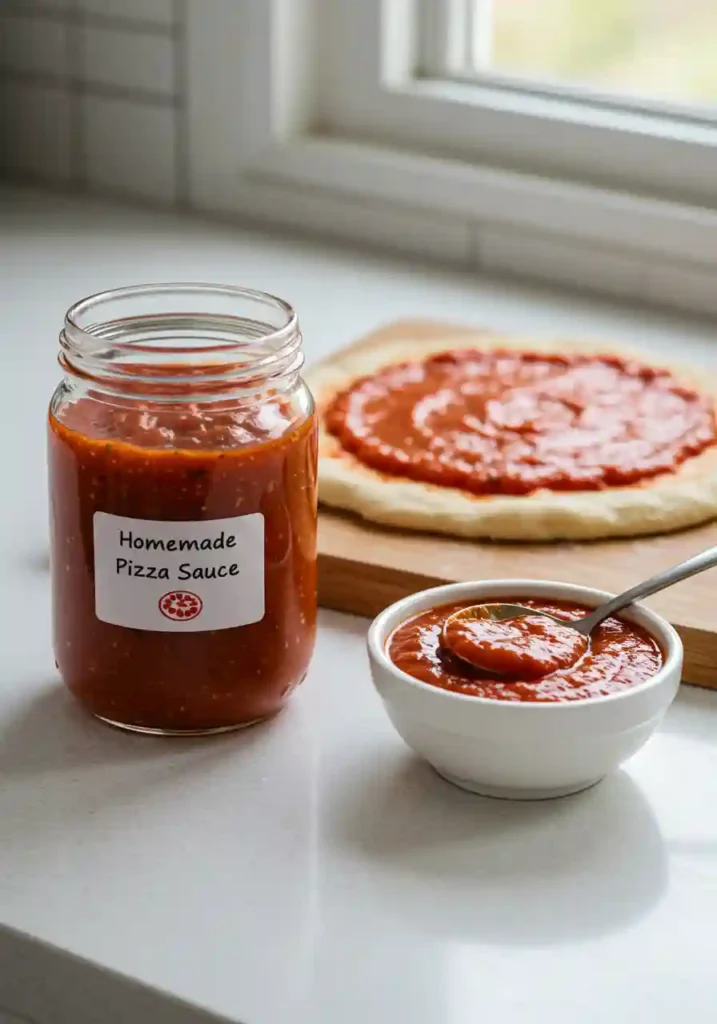
- Spread onto your pizza dough, add cheese and toppings, and bake as usual. If you have leftover sauce, keep it in an airtight container in the fridge for up to one week, or freeze for a couple of months.
That’s it! Simple enough to whip up on a busy weeknight for a quick homemade pizza.
Pro Tips and Variations
- Adjust Thickness
- For a chunkier sauce, you could mix in a small amount of diced tomatoes or leftover tomato sauce. Add them slowly to avoid thinning the sauce too much.
- For a chunkier sauce, you could mix in a small amount of diced tomatoes or leftover tomato sauce. Add them slowly to avoid thinning the sauce too much.
- Add Fresh Garlic or Onions
- If you have a few extra minutes, sauté minced garlic and finely chopped onions in olive oil, then stir them into the sauce for a deeper, more robust flavor.
- If you have a few extra minutes, sauté minced garlic and finely chopped onions in olive oil, then stir them into the sauce for a deeper, more robust flavor.
- Try Different Herbs
- Basil, oregano, thyme, or rosemary can add unique twists to your sauce. Experiment with fresh or dried versions of each.
- Basil, oregano, thyme, or rosemary can add unique twists to your sauce. Experiment with fresh or dried versions of each.
- Spice It Up
- If you love heat, double the red pepper flakes or stir in a bit of hot sauce.
- If you love heat, double the red pepper flakes or stir in a bit of hot sauce.
- Sweeten More
- If your sauce tastes too acidic, add a spoonful of sugar or honey. Maple syrup can also do the trick.
- If your sauce tastes too acidic, add a spoonful of sugar or honey. Maple syrup can also do the trick.
- Use as Dipping Sauce
- Warm the sauce gently and serve with breadsticks, mozzarella sticks, or leftover pizza crust. Perfect for a simple appetizer.
- Warm the sauce gently and serve with breadsticks, mozzarella sticks, or leftover pizza crust. Perfect for a simple appetizer.
- Meal Prep
- Double or triple the recipe and freeze in portion-sized containers. Then you’ll always have sauce ready when the pizza craving hits.
- Double or triple the recipe and freeze in portion-sized containers. Then you’ll always have sauce ready when the pizza craving hits.
Serving Suggestions
- Classic Pizza Night
Spread on a homemade or store-bought dough, layer your favorite toppings, and bake. Great for family dinners, potlucks, or casual get-togethers. - Calzones or Stromboli
Use this sauce inside the dough for a sealed pizza pocket. Serve extra sauce on the side for dipping. - Pasta or Lasagna
In a pinch, you can use this sauce for pasta dishes or as a layer in lasagna. It’s slightly thicker than typical marinara, so you might thin it further with water or stock. - Breakfast Pizza
Spread it on your dough, add scrambled eggs, cheese, and bacon for a fun breakfast or brunch twist. - Sauce for Casseroles
Spoon it over eggplant parmigiana, chicken parmesan, or other casserole-like bakes. The strong tomato flavor can enhance many recipes that call for tomato sauce.
Conclusion
Pizza sauce from tomato paste is your best friend when you need a quick, tasty, and budget-friendly sauce. The thick, concentrated nature of tomato paste ensures deep flavor, while simple spices transform it into a robust spread that works on various pizza styles—from thin-crust margherita to deep-dish supreme. No simmering for hours. No watery mess. Just a straightforward blend of tomato paste, herbs, water, and a few pantry staples, ready to shine on homemade pizza night or as a dipping sauce for breadsticks.
By mastering this base, you unlock unlimited potential for easy pizza dinners, calzones, or even sauce-based breakfasts. Keep a can of tomato paste in your pantry, and you’ll never run out of a quick pizza fix. Next time you crave fresh pizza at home, skip the jar, and whip up a batch of your own. Enjoy the flavors—fast and simple.
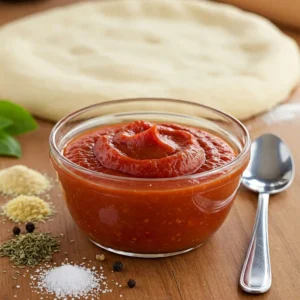
Pizza Sauce from Tomato Paste
Ingredients
Tomato Paste (6 oz can)
- Focus on plain tomato paste without added seasonings.
Water (½ cup, or to desired consistency)
- Thins out the paste. Adjust as you prefer thicker or thinner sauce.
Olive Oil (1 tablespoon)
- Brings smoothness and a bit of shine to the sauce.
Italian Seasoning (1 teaspoon)
- A ready-made blend of dried basil oregano, rosemary, and thyme. Or use your preferred combination.
Garlic Powder (½ teaspoon)
- Adds subtle garlic flavor without needing fresh garlic. Some prefer onion powder too.
Salt and Black Pepper (to taste)
- Fine-tune the base flavor. Start small add more if needed.
Sugar (1 teaspoon, optional)
- Balances the acidity of tomatoes. Skip if you prefer a tangy sauce.
Crushed Red Pepper Flakes (optional, pinch)
- For those who like heat.
Instructions
Gather Ingredients
- Open your 6 oz can of tomato paste. Measure out about ½ cup water. Grab your Italian seasoning, garlic powder, salt, pepper, and any optional extras you like.
Mix Paste and Water
- In a small bowl, whisk tomato paste and ¼ cup water to start. Add more water gradually until the sauce reaches a spreadable consistency. Some people prefer thick sauce; others like it a bit thinner.
Add Olive Oil and Seasonings
- Stir in 1 tablespoon olive oil. Then mix in 1 teaspoon Italian seasoning, ½ teaspoon garlic powder, plus salt and pepper to taste. If you want mild sweetness, include 1 teaspoon sugar. For heat, toss in a pinch of red pepper flakes.
Taste and Adjust
- Dip a spoon in and see if the sauce is too tangy, too thick, or lacking herbs. Add more sugar, water, or seasoning until it’s perfect for your taste buds.
Let It Sit (Optional)
- If you have 5–10 minutes, let the sauce rest so flavors meld. This step isn’t mandatory, but can slightly enhance taste.
Use Immediately or Store
- Spread onto your pizza dough, add cheese and toppings, and bake as usual. If you have leftover sauce, keep it in an airtight container in the fridge for up to one week, or freeze for a couple of months.
Notes
Nutrition Information (Per Serving)
Calories: 35 kcal Total Fat: 2g Saturated Fat: 0.3g Carbohydrates: 4g Sugar: 2g Fiber: 1g Protein: 1g Sodium: 180mg Cholesterol: 0mgFAQs
Below are answers to common questions related to making pizza sauce from tomato paste:
Does tomato paste work as pizza sauce?
Yes. Tomato paste, when combined with water and seasonings, can make a thick, rich sauce that’s perfect for spreading on pizza dough.
What happens if you use tomato paste instead of tomato sauce?
Tomato paste is more concentrated and thicker than tomato sauce, so you need to add water or other liquids to reach a spreadable consistency. The flavor also tends to be more intense.
What can I make with tomato paste?
Besides pizza sauce, you can use tomato paste in soups, stews, pasta sauce, or as a flavor booster in chili. It’s versatile for many tomato-based recipes.
What is the difference between pizza sauce and paste?
Pizza sauce is a ready-to-use mixture often made from crushed or pureed tomatoes plus herbs and spices. Paste is a concentrated form of tomatoes with most water removed, used as an ingredient to create sauces.
What is in traditional pizza sauce?
Traditional pizza sauce usually contains tomatoes (fresh or canned), olive oil, garlic, basil, oregano, salt, and pepper. Some variations include onions, sugar, or chili flakes.
How to thicken pizza sauce?
If your sauce is runny, simmer it briefly on the stove to reduce liquid, or stir in a little more tomato paste. Avoid overwatering in the first place if you want a thicker sauce.


